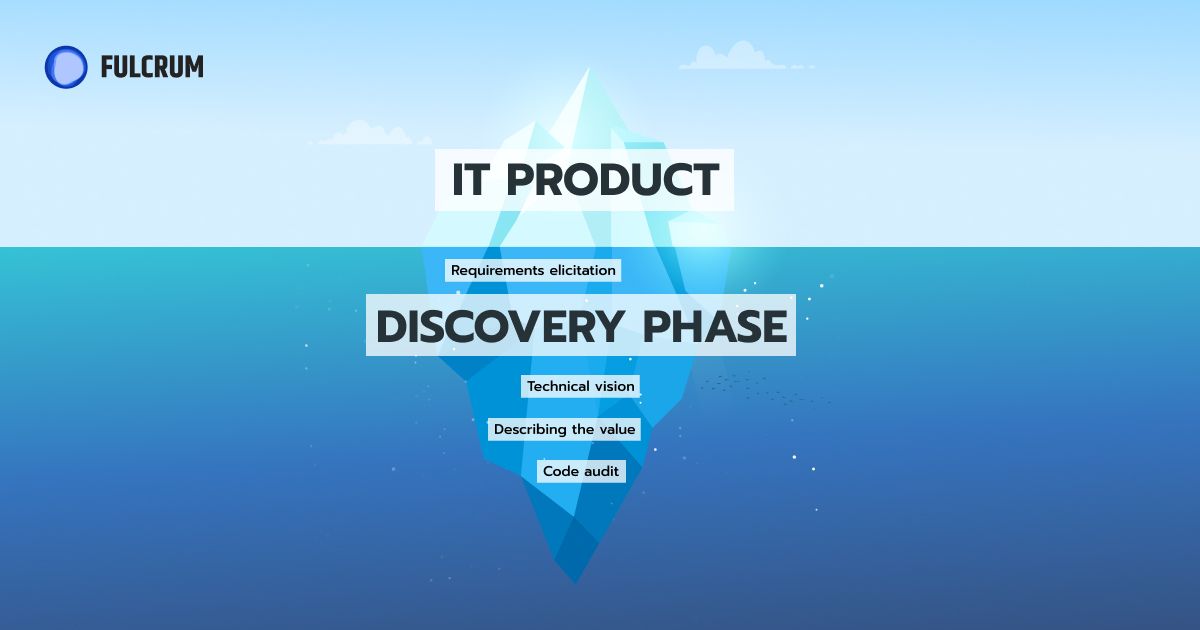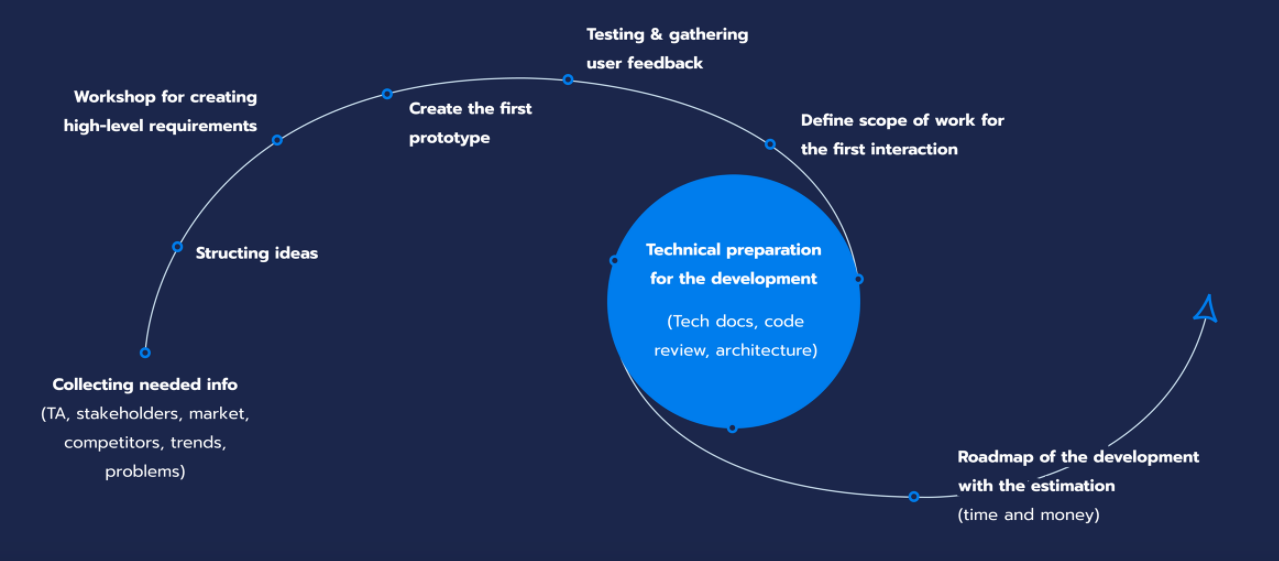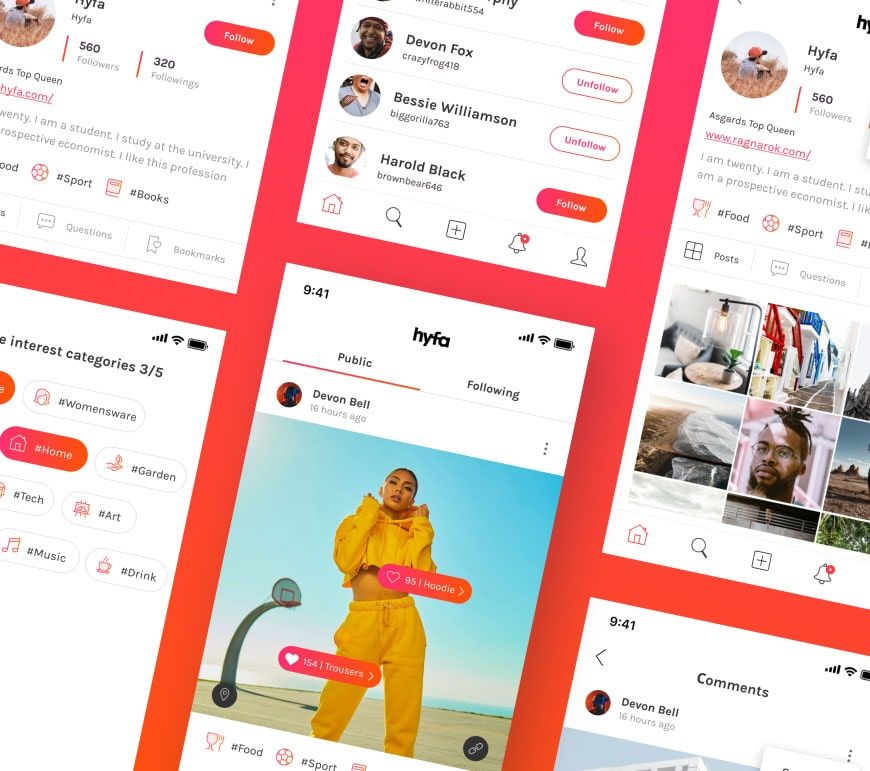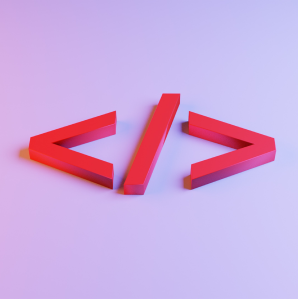For startup businesses, especially when developing IT products, going through the discovery phase with a reliable tech partner is like saving the place on a lifeboat. It’s a proven way to reduce risks, estimate & cut costs and create a reliable roadmap to achieve great business results.
Let’s have a look at some stats:

Yes, the business reality is harsh. And let’s be honest, there are no 100% guarantees for your business project to succeed. But discovery phase in software development will certainly increase your chances to create a high level digital product and substantially lower the risk of a product failure. This phase requires a top-notch tech expertise, so it’s better to entrust it to a service provider with a proven track record in developing software products.
Let’s delve into practice and see how the discovery process should be oraganized.

Project Discovery Phase ABC’s
Let’s cover the common questions you might have about the project discovery phase. If you know the basics, you can learn more about how we do discovery at Fulcrum. Otherwise, stay tuned to learn the basis.
Top 5 FAQ on discovery phase software development:
- What is a discovery phase?
- What is the purpose of a discovery phase?
- What happens during a discovery phase of a project?
- How do you run a discovery phase?
- How to start a product discovery?
We’ll be answering them one by one.
What is a discovery phase?
Discovery, (or scoping phase) is the initial stage in software development where the main focus is to get to know the end-user, clarify project vision, goals & scope, and identify risks.
During the discovery phase project team researches, collects and analyzes project information and plan an entire product development cycle. At this stage, you check if the product concept is viable, feasible, and usable.
What is the purpose of a discovery phase?
The big WHY is always at the core of every business, idea, or project. No wonder the same applies to the project discovery phase. In other words, WHY did this service come to exist? And WHAT is the need or purpose behind it? From Fulcrum experience, here are the top 5 Reasons Why:
- DETERMINE business goals, needs & product vision.
- BUILD product architecture to achieve specific business goals.
- MITIGATE development costs.
- IDENTIFY and downplay possible risks.
- CREATE clear product development roadmap.
What happens during a discovery phase of a project?
Discovery phase in software development is apparently a mystery to most people and even some business owners. It might sound profound and complex, but in reality it involves well-known business processes. Briefly, the project discovery process goes like this:
- Familiarizing with the client and their business idea (questionnaire, one-on-one meetings, brainstorming sessions, presentations).
- Discussing existing business processes and drawing the concept of the future project. At this stage, it is critical to align the client’s expectations and wishes with real deadlines.
- Defining target audiences of the product.
- Analyzing competitors and conducting extensive market research.
- Finding the best solutions to business problems.
- Determining the scope of work.
- Setting deadlines and priorities.
- Assigning roles and dedicating an expert team to the project.
- Receiving complete project PRD & proposal.
- Signing a contract for the discovery phase.
How do you run a discovery phase?
The basic workflow of the discovery phase project depends on the product development agency approach. At Fulcrum, we follow an agile discovery phase approach to software & product development.

Let us show you how it works with these 8 simple steps:
Step 1. Collecting needed info and creating user stories:
- Defining the target audience. To get to know the end-user, it is crucial to ask questions like: Who are your customers? What pains, problems & needs do they have? How do they think? How will your product help them? How can you connect with them? And so on… The idea is to keep asking until we know exactly who we’re creating a product for.
- Communication with stakeholders. Senior management and all interested parties should be involved in discussing the future software project. Conducting Interviews, collecting needed documentations, setting KPIs and other metrics – are usually done during this step.
- Market Analysis. “The truth behind the business success is simple – 99 %of the work is execution, and only 1 % is the idea.” And that’s the reason why our team spends so much time on tedious analytical work and careful planning. Market analysis & research are the fundamentals of the project discovery phase. It helps you choose a niche, pick the right financial model, develop a business strategy, and evaluate your prospects.
- Competitors Research. Study your competition, learn from them, improve using best practices and do even better!
- User Stories Creation. We love this tool! User stories are short and easy to read, understandable to developers, stakeholders, and users. They are organized into lists that we can effortlessly adjust at any time when new information becomes available.
Step 2. Structuring ideas
We use Mind mapping for that purpose. The mind map method is a visualization technique that helps structure all the information to see clearly the best solution for particular product development.
Step 3. Creating high-level requirements via workshops
Forming PRD (product requirement document) that includes all technical specifications for your product release. It lists out all desired functionality for the future software product. Simply put, if it is not in PRD, it will not be in the release.
Step 4. Creating the first prototype
A prototype is an interactive model of your software that looks and works just like your product should. The prototype shapes your idea and helps you prove the concept. Proof of Concept (PoC, for short) verifies that an idea is technically possible. It helps to validate functional assumptions and identify potential tech blockers.
Step 5. Testing and gathering user feedback
Flawed software can have an irreversible effect on revenue generation and reputation in the long run. Testing and collecting user feedback helps to create flawless products that meet all specifications and requirements.
Step 6. Defining the scope of work
Step 7. Preparing for the development (Tech Stack, code audit & high-level, architecture)
At this point, we collect all technical documentation (a set of documents that describe creation, installation, configuration, and use of the software) including results of code audit and product architecture (the structure behind your entire project that displays how functional elements of the software interact with each other).
Step 8. Estimating time & costs and creating a product development roadmap
Essentially, a roadmap is your product’s step-by-step development blueprint. It allows complete transparency about the project timelines, outlines key project stages & milestones, and gives you an easy-to-follow development plan. Along with the roadmap, our team also provides a precise time & cost estimation of the project and reviews possible cost reductions.
To sum it all up, after discovery is completed, you’ll have:
- Prototype
- Time & Cost Estimation
- Product Requirement Document (PRD)
- Architecture Documentation
- Roadmap
How to start a product discovery?
Quite easy, actually. We’re ready to consult and guide you throughout the entire product discovery process. We advice our clients to begin with discovery to ensure that the product development and launch will be smooth, and fit in the estimated deadlines and budgets.

Discovery Phase of Software Development FAQ
-
What are the 'resources' being assessed in the discovery phase?The first and mandatory part of the discovery process is the collection and systematization of customer requirements. The team gets a general vision of the project, determines the scope of business goals and objectives. Moreover, an expected result and success indicators of the project are discussed. Market research, finding bottlenecks, and initial development specification are also critical points of the discovery stage.
-
What happens after the discovery phase?The software project goes through a few stages. Once the initial discovery phase is completed, an actual development stage begins. By this stage, you already have system requirements specification, a preliminary UX prototype creating a custom solution, and MVP development plan, and estimates.
-
Why does Fulcrum rock the discovery stage?- Keeping the end user in mind. We create apps that enchant your users first, keeping their best interests in mind. - Exact business analysis. We are a product-oriented team. We make sure your app fits the market answers user requests. - We fight for your project's goals. Each project is a love story. We do 150% out of possible 100% to make sure your project is a success. - You are always up-to-date. You will always know the project status. We have weekly/daily meetings, use Jira, and Slack. Our response time - 1 hour.


